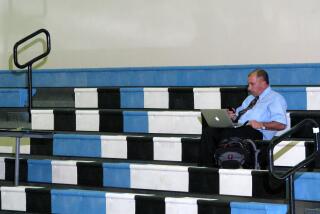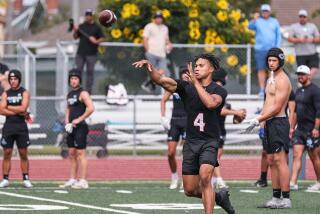JSerra Co-Founders Bruised but Not Regretful As Expansion Proceeds
When they began mapping plans six years ago for another Roman Catholic high school in Orange County, Marc Spizziri and Tim Busch figured their rivals would eventually be Mater Dei, Santa Margarita and Servite -- the area’s largest parochial schools.
The co-founders of Junipero Serra High School discovered soon enough that their biggest rival was in their own backyard -- the Juaneno Band of Mission Indians.
Outraged that the school, known as JSerra, was planning to build its athletic complex atop their ancestors’ burial grounds, a group of Juanenos surprised Spizziri and Busch by waging a 2 1/2 -year-fight to halt the project. The Juanenos’ battle included almost daily protests outside the school, two lawsuits, two heated City Council meetings and a petition drive that ended in early November when petitioners failed to gather enough signatures to hold an election to challenge the project.
Construction finally began Nov. 18 on the $75-million athletic and arts complex across the street from the year-old school’s main campus, but Spizziri and Busch acknowledged that the controversy took a toll. Enrollment was projected to be 300 the first year and 600 this year, but it has turned out to be barely half of that each year.
“It cost us immeasurably,” Spizziri said. “Our enrollment was adversely affected, and we were delayed on our building. A lot of the news reports were not favorable, but fortunately there were 312 people that had the faith.”
Among them was former National Football League player John Cappelletti, whose family received an education they hadn’t counted on the last three semesters.
“There’s no blueprint for a new school, but you expect the growing pains,” said Cappelletti, a Heisman Trophy winner at Penn State and former Los Angeles Ram whose son Joseph plays football at Serra. “You don’t expect to be attending City Council meetings to show support for your school or sending your son door-to-door to fight a petition drive. This has definitely been a great learning experience for Joseph and all of us.”
For Spizziri and Busch, it was a learning experience they never counted on. Serra was supposed to open in September 2001 less than a mile from the current site, on 35 acres of land owned by Rancho Capistrano Ministries. But Rancho Capistrano broke off talks to sell the land because of Serra’s requirement that religion teachers at the school be “practicing Catholics.”
When Spizziri and Busch settled on a 29-acre parcel of open space on Junipero Serra Road, alongside Interstate 5, they knew the land was sacred ground for the Juanenos. So they met with tribal leader David Belardes, who agreed to support the school after campus officials promised not to destroy burial sites and to erect monuments recognizing tribal leaders.
“We thought everything was going to go wonderfully.... Then we found out there was not one, not two, but three factions” of the tribe, Spizziri said.
The two other Juaneno groups, led by Damien Shilo and Sonia Johnston, rejected compromise and demanded the land be reserved for a cultural center to honor their ancestors. Armed with the belief that dozens and maybe hundreds of their ancestors were buried on the land, Shilo’s and Johnston’s groups chanted prayer songs and hoisted signs while parents drove their children onto campus as the school opened in fall 2003.
The Juanenos were not the only ones protesting the school’s expansion. Environmentalists and residents of a condominium complex who lived adjacent to the 29 acres rallied around the Juanenos’ cause, pummeling the school co-founders at council meetings and in newspapers. “The most hurtful thing we heard was that we were in it for the money,” Busch said. “That’s insane. There’s no for-profit school at the secondary level anywhere in the country.... We’re here to donate money.”
The two wealthy businessmen, who also co-founded St. Anne’s elementary and middle school in Laguna Niguel, have donated millions of dollars and hundreds of hours to Serra. In fact, Busch, Spizziri and Tom Parr, also a donor at St. Anne’s, guaranteed the bank debt of $53 million on the main campus and the south campus, where the athletic fields and cultural arts center are being built.
“Some weeks I spend 80% of my time on school-related work,” said Spizziri, who owns two car dealerships in south Orange County and has two children attending Serra. “During the referendum, it was more like 110% of my time.”
Busch, an Irvine tax attorney, said at least half of his week is spent on school-related issues, but he’s not complaining. “God will give us far greater return than we have ever put forward,” said Busch, who has a daughter in the freshman class. “And he has.”
Hoping to make up for lost time, school officials are counting on the spring sports teams -- baseball, softball and tennis -- to be playing on their own fields in the coming season. The girls and boys basketball teams are expected to move into their 2,000-seat gymnasium by November 2005. But the construction delays have been costly to Serra’s athletic program, one of the school’s major selling points in an area regarded as a hotbed for youth sports.
Originally, Serra planned to join Mater Dei, Santa Margarita and Servite in the Serra League by 2005. Spizziri said 2010 now seems more realistic. This fall, the varsity football team forfeited a midseason game against Los Angeles Baptist because it had only 13 healthy players. For the rest of the season, the governing body of high school athletics -- the California Interscholastic Federation -- relegated Serra to junior varsity status. Spizziri said the low numbers on the football squad could be blamed on the stalled athletic field situation, which he said prompted at least a half-dozen freshmen to transfer to Santa Margarita and nearby public schools last summer.
Busch said it has never been his goal to build a sports power, but he stressed that athletics “is an essential element of the high school experience.”
“I’m a big believer that we have spent way too much focusing on academics instead of the child’s gifts,” he said. “Not everybody is an ‘A’ student. Many of the successful people, those running our Fortune 500 companies, weren’t ‘A’ students either. In athletics, we’re trying to teach kids how to get along with people. It isn’t about getting your way all the time; it’s about working out a way that makes sense.”
Though Busch and Spizziri didn’t always get their way, they did ultimately prevail. Neither man has regrets, but neither appears eager to open a third private school any time soon.
“If I knew what I know now, I’m not sure I’d have chased this one,” Spizziri said. “It’s hard to do something that we see as a positive thing and to be constantly attacked.”
More to Read
Sign up for Essential California
The most important California stories and recommendations in your inbox every morning.
You may occasionally receive promotional content from the Los Angeles Times.










